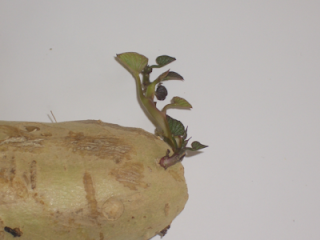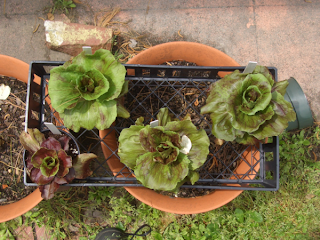Welcome back to another episode of lost in the farmer’s
market where we discuss the horticultural events of the day. In this episode
I’ve got some neat stuff to discuss and the first thing on the list is the
rapid shift in the political tides against the Monsanto Protection act. It
seems one of the original signers of the item has actually read it and decided
it’s a terrible thing. How about that, maybe it should be a law that in order
to run for office you must read cover to cover any law or bill that is up for a
vote with a neutral third party witness present.
For those who do not yet know the Monsanto protection act
was an act that gave Monsanto immunity form lawsuit in federal court should it
be found that one of their Franken-crops is found to be causing damage to
public health or the environment. How Ironic, this comes after a decade of
Monsanto Franken-crop screwups including the Monarch butterfly killing corn,
The displacement of native forms of Maize in south America and the company’s
rabid attacks on local farmers over their growing of crops contaminated by
Monsanto’s GMO crops. I mean I have to ask when Monsanto will stop acting like
the Sony of the Agriculture world. You might remember how sony at one point
tried to claim that when you buy a CD you don’t won the music on it just a
license to listen to it, well Monsanto as a company is no less ridiculous as is
seen in the article on the link below.
http://www.nytimes.com/2013/02/20/business/justices-signal-a-monsanto-edge-in-patent-case.html?_r=0
Needless to say the implications of that trial are troubling
because it increases Monsanto’s pretext to force more farmers out of business
due to crop contamination. Monsanto can now go about invading private property,
stealing samples contaminating genetic diversity and suing small farmers out of
existence and in the case of Bowman v. Monsanto the courts seem to have given
the green light. In case some of you don’t recall Monsanto is also responsible
for Roundup which was originally labeled as Ecologically safe but the label had
to be removed after a court challenge and testing determined that Roundup does
not in fact break down in the environment and can seep into the ground water. I
know what some of you might say, yes companies need legal protections for their
product but when your product is a living thing, the right to patent is
entirely unjust. It reminds me of the case where a specific company actually
has a patent on two primary genes that have to do with the probability of specific
forms of cancer.
http://www.aclu.org/free-speech-technology-and-liberty-womens-rights/association-molecular-pathology-v-myriad-genetics
In this particular case it means that without paying said
company a lot of cash, no one can test for the said genes to determine likely
hood of the cancer being a problem. This in turn means the cost of getting the
test from anyone is higher, and thus less of the population is likely to get
the test and the mortality rate is not going to get any better. It’s funny, I
thought the medical profession was there to do no harm, but all I see here is
harm. From an economic standpoint the folks that often support such patents on
living organisms, often claim to believe in free market economics and yet don’t
realize such patents effectively eliminate competition and thus are the exact
opposite of the economics they claim to espouse. On the biology front one has
to consider if it’s right to have legal rights to own any sort of organism
found in nature. If this sort of legal corporate ownership is ok what is next,
suddenly everyone has to pay to use their body parts?
But there is hope in an odd way, Last summer there were
verified reports of certain ‘weed’ species developing immunity or resistance to
roundup. Specifically two forms of amaranth developed roundup immunity and were
choking out roundup ready corn crops. The irony is amaranth is a very edible
species of plants, that will grow just about anywhere and requires very little
in the way of fertilizer or specialized soil. A large segment of the world eats
amaranth as a food staple, and yet we have starving folks in the USA, and
massive corn crops that are the vertical equal in usefulness to lawn grass. To
put the fight against GMO in contexts one has to consider that the companies
that produce GMO crop plants are a little like the Hydra of myth, every time we
score a victory by cutting off a head new ones grow back, and thus we face a
more difficult confrontation. I think the only way to finally get all GMO
absolutely labeled and companies such as Monsanto in check is to first to
educate the nations consumers about what they are up against. Now going back to
the issue with Monsanto, the problem as it stands is that they don’t want
anyone growing their special round-up ready crops without a signed contract.
They also don’t want their materials labeled as GMO, and don’t want farmers
saving seed, or any real serious third party investigations into their product.
You know what this behavior sounds like? Two words folks Organized Crime,
that’s right, the fight to get rid of GMO isn’t just a slogan, and it’s a
battle against criminal greedy behavior by several companies who don’t care
about what their product does to you.
The way to cauterize
the hydra’s stumps in this case is economic and informational action. If no
money is rolling into a company’s coffers for long enough they go belly-up, in
the same way if a company is getting such a great public backlash that their
media machine cant function, they come apart because the economic angle
eventually follows. That said if you’re on the fence about the GMO thing, then
check out Sustainable Neighbors and they can give you some great information.
http://www.meetup.com/SustainableNeighbors/
As an end note to this article I will be at the Fayetteville
Farmers Market on Saturday between 9am and 1pm. The market is located at 325 Franklin Street
at the Fayetteville
Transportation Museum
property. My table is next to the Sustainable Neighbors table and you can come
check us out or merely pick our brains about sustainability and garden stuff or
just have a chat. As always this is the list of what will be coming to market
this week.
Cucumbers &
Melons: Armenian Cucumber (1x).
Leaf Greens:
Turkish Rocket (2x), Red Malabar Spinach (1x)
Herbs: Mountain
Mint* (3x).
Ornamentals: Castor
Bean “Red Weed” (2x)
Tomatoes: Purple
Calabash (2x).
Eggplant: Nyakati
(1x), Early Black Egg (1x).
Peppers: Cayenne Purple (2x), Lemon Drop (3x), Carolina Wonder (4x), Chinese Ornamental
(2x).
Vegetables: Red Burgundy Okra (6x)
Potatoes: Dark
Caribe (1x), Carola (5x), 3” Dark Caribe Potato starts (1x), 3” Carola Potato
Starts (6x) .
Bean: Asian
Winged Bean (2x)
“Marsha’s ‘Maters”:
3” pot size - Roma Tomato (4x), Beefsteak Tomato (4x).
4” pot size – Beefsteak Tomato (6x)
House Plants:
2” pot Rhipsalis salicornoides ‘Drunkards Dream Cactus
3” pot Heurnia zebrine ‘Lifesaver Cactus’
6” pot Huernia schneideriana ‘Dragon Cactus’
*Pycnanthemum muticum
– Short Toothed Mountain Mint
All that great horticulture information and action aside
this brings to a close another episode of LITFM. Remember to be wary of those
summer pop-up thundershowers as they work wonders for plant growth but the
lighting is certainly no joke. As always folks keep ‘em growing!






























